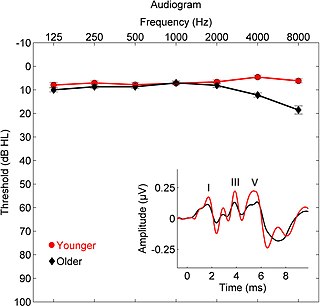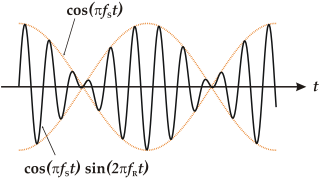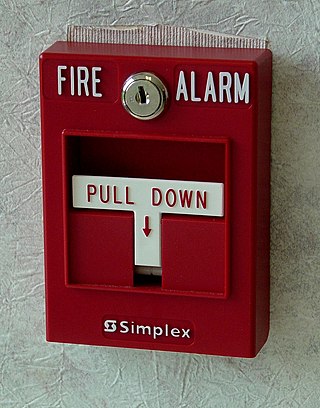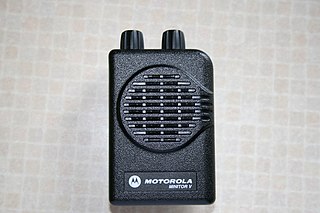
Frequency, measured in hertz, is the number of occurrences of a repeating event per unit of time. It is also occasionally referred to as temporal frequency for clarity and to distinguish it from spatial frequency. Ordinary frequency is related to angular frequency by a factor of 2π. The period is the interval of time between events, so the period is the reciprocal of the frequency: f = 1/T.

A subwoofer is a loudspeaker designed to reproduce low-pitched audio frequencies known as bass and sub-bass, lower in frequency than those which can be (optimally) generated by a woofer. The typical frequency range for a subwoofer is about 20–200 Hz for consumer products, below 100 Hz for professional live sound, and below 80 Hz in THX-certified systems. Thus one or more subwoofers are important for high quality sound reproduction as they are responsible for the lowest two to three octaves of the ten that are audible. This very low-frequency (VLF) range reproduces the natural fundamental tones of the bass drum, electric bass, double bass, grand piano, contrabassoon, tuba, in addition to thunder, gunshots, explosions, etc.

The absolute threshold of hearing (ATH), also known as the absolute hearing threshold or auditory threshold, is the minimum sound level of a pure tone that an average human ear with normal hearing can hear with no other sound present. The absolute threshold relates to the sound that can just be heard by the organism. The absolute threshold is not a discrete point and is therefore classed as the point at which a sound elicits a response a specified percentage of the time.

A smoke detector is a device that senses smoke, typically as an indicator of fire. Smoke detectors are usually housed in plastic enclosures, typically shaped like a disk about 150 millimetres (6 in) in diameter and 25 millimetres (1 in) thick, but shape and size vary. Smoke can be detected either optically (photoelectric) or by physical process (ionization). Detectors may use one or both sensing methods. Sensitive alarms can be used to detect and deter smoking in banned areas. Smoke detectors in large commercial and industrial buildings are usually connected to a central fire alarm system.

In a radio receiver, a beat frequency oscillator or BFO is a dedicated oscillator used to create an audio frequency signal from Morse code radiotelegraphy (CW) transmissions to make them audible. The signal from the BFO is mixed with the received signal to create a heterodyne or beat frequency which is heard as a tone in the speaker. BFOs are also used to demodulate single-sideband (SSB) signals, making them intelligible, by essentially restoring the carrier that was suppressed at the transmitter. BFOs are sometimes included in communications receivers designed for short wave listeners; they are almost always found in communication receivers for amateur radio, which often receive CW and SSB signals.

A fire alarm control panel (FACP), fire alarm control unit (FACU), fire indicator panel (FIP), or simply fire alarm panel is the controlling component of a fire alarm system. The panel receives information from devices designed to detect and report fires, monitors their operational integrity, and provides for automatic control of equipment, and transmission of information necessary to prepare the facility for fire based on a predetermined sequence. The panel may also supply electrical energy to operate any associated initiating device, notification appliance, control, transmitter, or relay. There are four basic types of panels: coded panels, conventional panels, addressable panels, and multiplex systems.

In acoustics, a beat is an interference pattern between two sounds of slightly different frequencies, perceived as a periodic variation in volume whose rate is the difference of the two frequencies.

Manual fire alarm activation is the process of triggering a fire alarm through a call point, pull station, or other device. This usually causes the alarm to sound the evacuation signal for the relevant building or zone. Manual fire alarm activation requires human intervention, as distinct from automatic fire alarm activation such as that provided through the use of heat detectors and smoke detectors. It is, however, possible for call points/pull stations to be used in conjunction with automatic detection as part of the overall fire detection and alarm system. Systems in completed buildings tend to be wired in and include a control panel. Wireless activators are common during construction.

A fire alarm system is a building system designed to detect and alert occupants and emergency forces of the presence of smoke, fire, carbon monoxide, or other fire-related emergencies. Fire alarm systems are required in most commercial buildings. They may include smoke detectors, heat detectors, and manual fire alarm activation devices, all of which are connected to a Fire Alarm Control Panel (FACP) normally found in an electrical room or panel room. Fire alarm systems generally use visual and audio signalization to warn the occupants of the building. Some fire alarm systems may also disable elevators, which under most circumstances, are unsafe to use during a fire.

Wheelock is a fire alarm and general signaling products manufacturer owned by Eaton Corporation.
In a conventional, analog two-way radio system, a standard radio has noise squelch or carrier squelch, which allows a radio to receive all transmissions. Selective calling is used to address a subset of all two-way radios on a single radio frequency channel. Where more than one user is on the same channel, selective calling can address a subset of all receivers or can direct a call to a single radio. Selective calling features fit into two major categories—individual calling and group calling. Individual calls generally have longer time-constants: it takes more air-time to call an individual radio unit than to call a large group of radios.

The Motorola Minitor is a portable, analog, receive only, voice pager typically carried by fire, rescue, and EMS personnel to alert of emergencies. The Minitor, slightly smaller than a pack of cigarettes, is carried on a person and usually left in selective call mode. When the unit is activated, the pager sounds a tone alert, followed by an announcement from a dispatcher alerting the user of a situation. After activation, the pager remains in monitor mode much like a scanner, and monitors transmissions on that channel until the unit is reset back into selective call mode either manually, or automatically after a set period of time, depending on programming.
In audio signal processing, auditory masking occurs when the perception of one sound is affected by the presence of another sound.

A muster drill, sometimes referred to as a lifeboat drill or a boat drill, is an exercise that is conducted by the crew of a ship prior to embarking on a voyage. A muster drill prepares passengers for safe evacuation, in the event of an emergency on board the ship, and familiarizes the crew and the passengers with escape routes. In a muster drill, the use of life vests and the escape routes from the ship are explained to the passengers. It is typically conducted approximately 30 minutes prior to the ship's scheduled departure time, and all guests must remain silent during the drill so that everyone will be able to hear the safety announcements from the captain. To alert that the drill is in progress, a general emergency alarm is sounded, and the captain then explains what the passengers need to do.

In physics, sound is a vibration that propagates as an acoustic wave through a transmission medium such as a gas, liquid or solid. In human physiology and psychology, sound is the reception of such waves and their perception by the brain. Only acoustic waves that have frequencies lying between about 20 Hz and 20 kHz, the audio frequency range, elicit an auditory percept in humans. In air at atmospheric pressure, these represent sound waves with wavelengths of 17 meters (56 ft) to 1.7 centimeters (0.67 in). Sound waves above 20 kHz are known as ultrasound and are not audible to humans. Sound waves below 20 Hz are known as infrasound. Different animal species have varying hearing ranges.
Faraday is a Florham Park, New Jersey company that specializes in fire protection systems.

A vehicle horn is a sound-making device installed on motor vehicles, trains, boats, and other types of vehicles. The horn is activated to warn others of the vehicle's presence or approach, or to call attention to some hazard. Motor vehicles, ships and trains are required by law in some countries to have horns. Trams, trollies, streetcars, and even bicycles are also legally required to have an audible warning device in many areas.
Psychoacoustics is the branch of psychophysics involving the scientific study of sound perception and audiology—how human auditory system perceives various sounds. More specifically, it is the branch of science studying the psychological responses associated with sound. Psychoacoustics is an interdisciplinary field of many areas, including psychology, acoustics, electronic engineering, physics, biology, physiology, and computer science.
Autocall is a company that specializes in fire protection and customized communications equipment. The original company was founded in 1908 and was based in Shelby, Ohio. The Autocall brand became defunct in 2001 after it was incorporated into the SimplexGrinnell merger by Tyco International. On September 6, 2016, Johnson Controls and Tyco completed a merger, and Johnson Controls relaunched the Autocall brand in late 2017.

System Sensor is a company headquartered in St. Charles, Illinois, dedicated to the research, development and manufacture of fire protection equipment. System Sensor is a part of the Honeywell Life Safety Group. System Sensor develops and distributes fire alarm devices such as notification appliances, fire detectors, manual initiating devices, CO detectors, and more fire protection devices for multiple markets across the globe, and for other Honeywell companies.
















